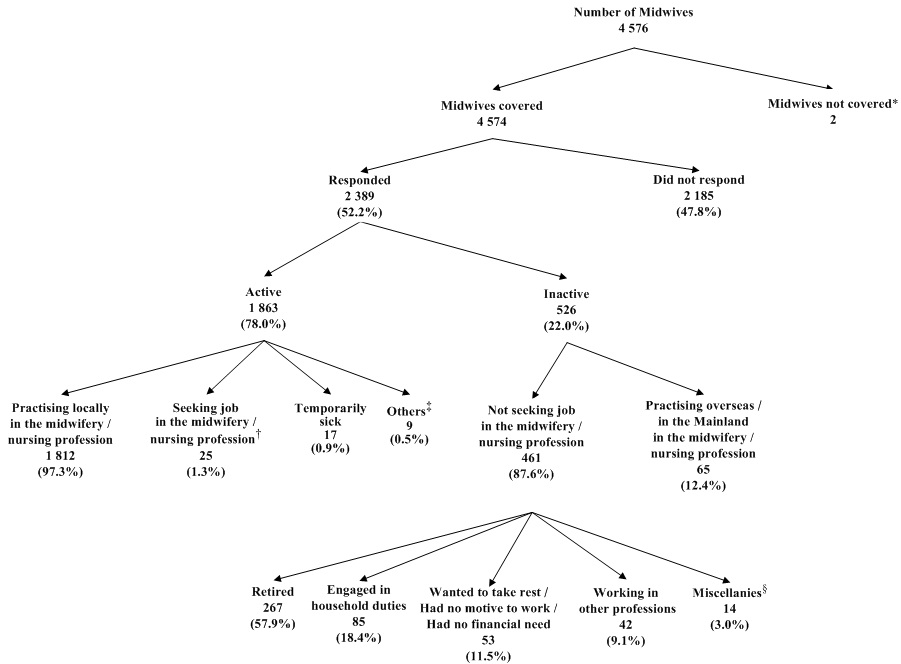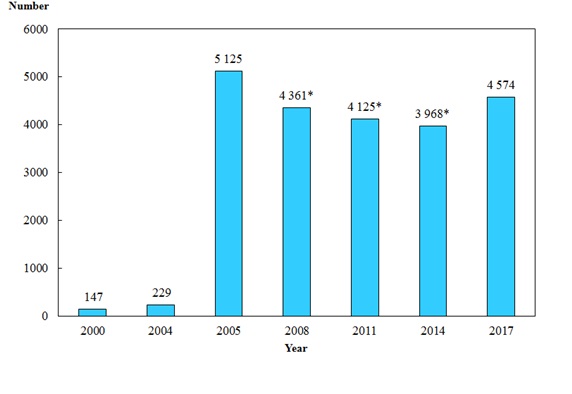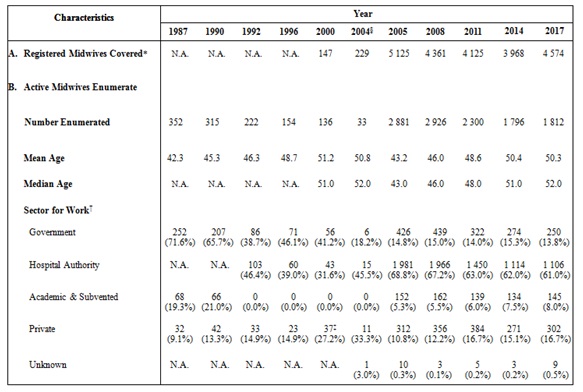Statistics
2017 Health Manpower Survey
Summary of the Characteristics of Registered Midwives Enumerated
I. Registered Midwives Covered
1.1 The midwives covered in the 2017 Health Manpower Survey on midwives (HMS-MW) were midwives registered with the Midwives Council of Hong Kong under the Midwives Registration Ordinance (Chapter 162) as at the survey reference date of 31 August 2017, with exclusion of those subsequently found to have passed away on or before the survey reference date.
1.2 The number of midwives covered was 4 574.
1.3 Of the 4 574 midwives covered, 2 389 responded to the HMS-MW, giving an overall response rate of 52.2%. Among the respondents, 1 863 (78.0%) were economically active*† (active) and 526 (22.0%) were economically inactive*‡ (inactive) in the local midwifery / nursing profession (Chart A) .
1.4 Of the 1 863 active midwives enumerated, 1 812 (97.3%) were practising in the local midwifery / nursing profession, 25 (1.3%) were seeking jobs, 17 (0.9%) were having temporary sickness and nine (0.5%) were expecting to return to their original jobs or waiting to take up a new job in the local midwifery / nursing profession during the 30 days before the survey. The survey results presented in paragraph 1.6 below were based on the 1 812 responding midwives who were practising in the local midwifery / nursing profession as at 31 August 2017. The percentages presented below may not add up to 100% due to missing responses or rounding.
1.5 Of the 526 inactive midwives enumerated, 65 (12.4%) reported practising overseas / in the Mainland and 461 (87.6%) midwives reported not seeking job in the local midwifery / nursing profession during the 30 days before the survey (Chart A) . Among the 461 inactive midwives who reported not practising in Hong Kong and not seeking jobs in the local midwifery / nursing profession, the main reasons reported not seeking job included: 267 (57.9%) were retired, 85 (18.4%) were engaged in household duties, 53 (11.5%) wanted to take rest / had no motive to work / had no financial need, and 42 (9.1%) were working in other professions.
* In the survey, the criteria used in defining economically active / inactive followed those recommended by the International Labour Organization, which are also being used by the Census and Statistics Department in Hong Kong.
† "Economically active" midwives comprised all "employed" and "unemployed" midwives. "Employed" midwives referred to those midwives practising in the midwifery / nursing profession in Hong Kong during the survey period, while "unemployed" midwives referred to those midwives who (a) were not practising in the midwifery / nursing profession during the survey period; (b) had been available for work during the seven days before the survey; AND (c) had sought work in the local midwifery / nursing profession during the 30 days before the survey.
‡ "Economically inactive" midwives comprised the midwives who were not practising in the midwifery / nursing profession in Hong Kong during the survey period, excluding those who had been on leave during the survey period and who were "economically active" but "unemployed".
Chart A : Activity Status of Midwives Covered

|
Note:
|
* | Figure refers to the number of midwives subsequently found to have passed away on or before 31.8.2017. |
| † | Figure refers to the number of responding midwives who (a) were not practising in the midwifery / nursing profession in Hong Kong during the survey period; (b) had been available for work during the seven days before the survey; AND (c) had sought work in the local midwifery / nursing profession during the 30 days before the survey. | |
| ‡ | Figure refers to the number of responding midwives who (a) were not practising in the midwifery / nursing profession in Hong Kong during the survey period; (b) had been available for work during the seven days before the survey; AND (c) were expecting to return to their original jobs or waiting to take up a new job in midwifery / nursing profession during the 30 days before the survey. | |
| § | Figure refers to the number of responding midwives who reported emigrated, undertaking study, etc. | |
| Percentages may not add up to 100% due to rounding. |
1.6 All the 1 812 active midwives enumerated were female. Apart from 50 midwives who did not indicate the age, the median age of the remaining 1 762 active midwives enumerated was 52.0 years. Among the active midwives enumerated, those aged 50 to 54 years accounted for the largest proportion (30.7%), followed by those aged 55 to 59 years (23.6%) and aged 45 to 49 years (14.7%).
1.7 The responding active midwives were requested to indicate the characteristics of their main jobs*. Distribution by sector for the main job showed that 1 106 (61.0%) of the active midwives were working in the Hospital Authority, followed by 302 (16.7%) in the private sector, 250 (13.8%) in the Government, 85 (4.7%) in the subvented sector and 60 (3.3%) in the academic sector..
1.8 The median ages of the active midwives enumerated were highest for those working in the academic and subvented sectors (both 55.0 years), followed by the Government (54.0 years), the private sectors (53.0 years) and the Hospital Authority (51.0 years).
1.9 Of the 1 812 active midwives enumerated, 31.6% spent most of their working time on obstetrics, followed by 10.0% on public health, 9.2% on administration / management and 9.1% on medicine.
1.10 The median number of hours of work (excluding meal breaks) per week of the 1 812 active midwives enumerated was 42.0 hours. Among them, 125 (6.9%) midwives were required to undertake on-call duty (excluding normal duty), with a median of 17.0 hours of on-call duty (excluding normal duty) per week.
1.11 In terms of earliest basic qualification† in midwifery / nursing profession, of the 1 812 active midwives enumerated, Student / Pupil Nurse Training accounted for 74.6%, whilst Bachelor’s Degree, Pupil Midwife Training and Higher Diploma accounted for 11.6%, 6.1% and 6.0% respectively.
1.12 Of the 1 812 active midwives enumerated, 1 797 (99.2%) had received / were receiving additional training, which is relevant to the midwifery / nursing profession after obtaining their earliest basic qualification. Among these 1 797 active midwives, 605 (33.7%) held Bachelor’s Degree, 600 (33.4%) held Master’s Degree, 255 (14.2%) held diploma as the highest qualification and ten (0.6%) had not yet completed the additional training.
* Main jobs referred to the jobs in which the midwives had spent most of their working time.
† Earliest Basic qualification refers to the minimum entry qualification to the midwifery / nursing profession obtained by the registered midwives. If the midwives had the earliest basic qualifications in both nursing and midwifery professions, they were requested to indicate the earlier minimum entry qualification among these earliest basic qualifications that they obtained.
1.13 Of the 1 797 active midwives who had received / were receiving additional training after obtaining their earliest basic qualification, 626 (34.8%) had received / were receiving training in one field only. Among them, 92.7% were trained in midwifery, 2.2% in general nursing, and 0.6% for both paediatric nursing and public health nursing.
1.14 For the active midwives enumerated who had indicated more than one field of additional training, the total number of counts of midwives enumerated for additional training was 3 820. Among these 3 820 counts, training in midwifery, general nursing, public health nursing and nursing administration accounted for 45.5%, 6.3%, 4.7% and 4.7% respectively.
1.15 Regarding Post-registration Education in Midwifery (PEM) / Continuing Nursing Education (CNE) activities, 1 546 (85.3%) of the active midwives reported that they had participated in PEM / CNE activities in 2017, 224 (12.4%) reported no participation in any PEM / CNE activities, whilst 42 (2.3%) did not report whether they had participated in PEM / CNE or not. Among the 1 546 active midwives enumerated who had participated in PEM / CNE activities, the distribution of PEM / CNE points / hours attained in the past 12 months was: 1 to 5 points / hours (14.4%), 6 to 10 points / hours (14.3%), 11 to 15 points / hours (19.1%), 16 to 20 points / hours (13.1%) and more than 20 points / hours (39.1%).
II. Trend Analysis
2.1 Comparison of findings of the 2017 HMS-MW with those surveys conducted on or before 2004 should be made with caution as the survey methods and reference date had been changed.
2.2 Active registered midwives practising in the institutions enumerated were covered in the HMS before 2004. With the introduction of practising certificate by the Midwives Council in January 2000, the method adopted in counting registered midwives were changed to include registered midwives who had valid practising certificates in midwifery as at the survey reference date. Survey coverage for 2004 and thereafter are as follows:
- Only registered midwives who had valid practising certificates in midwifery as at the survey reference date and who had no valid practising certificate in registered nurses or enrolled nurses were covered in 2004.
- All registered midwives who registered with the Midwives Council of Hong Kong as at 31.8.2005 were covered in 2005 survey.
- The midwives covered in 2008, 2011 and 2014 were midwives registered with the Midwives Council of Hong Kong as at 31st of August of the respective years and had to renew their practising certificates in respective years.
- All registered midwives who registered with the Midwives Council of Hong Kong as at 31.8.2017, excluding those who were found to have passed away on or before the survey reference date, were covered in the 2017 survey.
2.3 Because of the changing survey methodologies, the number of midwives covered varied from 147 to 5 125 during the survey years between 2000 and 2017 (Chart B) .
Chart B : Number of Registered Midwives Covered by Year (2000, 2004, 2005, 2008, 2011, 2014 and 2017)

| Note: | * | As the 2008, 2011 and 2014 Health Manpower Survey only aimed at covering all registered midwives who had to renew their practising certificates in 2008, 2011 and 2014, registered midwives who did not need to renew practising certificates in 2008, 2011 and 2014 were excluded from the survey. |
| Figure of 2000 refers to the number of registered midwives without registered nurses and enrolled nurses qualification and reported by the responding institutions as at 1.7.2000, whereas the figure of 2004 refers to the number of registered midwives (excluding registered nurses or enrolled nurses holding valid practising certificates in midwifery as at 31.8.2004) registered with the Midwives Council of Hong Kong as at 31.8.2004. Figure of 2005 refers to the number of midwives registered with Midwives Council of Hong Kong as at 31.8.2005. Figures of 2008, 2011 and 2014 refer to the number of midwives registered with the Midwives Council of Hong Kong as at the 31st of August of the respective years and had to renew their practising certificates in respective years. Figure of 2017 refers to the number of midwives registered with Midwives Council of Hong Kong as at 31.8.2017 with exclusion of those who were subsequently found to have passed away on or before the survey reference date. |
2.4 In view of a large variation in the number of midwives enumerated secondary to different survey methodologies in the past, it would be desirable to restrict comparison to data between year 2005 and 2017. The mean age of the active midwives enumerated increased from 43.2 years in 2005 to 50.3 years in 2017.
2.5 From 2005 to 2017, the largest proportion (over 60%) of active midwives enumerated were working in the Hospital Authority. The proportion of active midwives enumerated working in the Hospital Authority decreased from 68.8% in 2005 to 61.0% in 2017. On the other hand, the proportion of active midwives enumerated working in the private sector gradually increased from 10.8% in 2005 to 16.7% in 2017 (Table A) .
Table A : Selected Characteristics of Active Midwives Enumerated (1987, 1990, 1992, 1996, 2000, 2004, 2005, 2008, 2011, 2014 and 2017)

|
Note:
|
* | Figure of 2000 refers to the number of registered midwives without registered nurses and enrolled nurses qualification and reported by the responding institutions as at 1.7.2000, whereas the figure of 2004 refers to the number of registered midwives (excluding registered nurses or enrolled nurses holding valid practising certificates in midwifery as at 31.8.2004) registered with the Midwives Council of Hong Kong as at 31.8.2004. Figure of 2005 refers to the number of midwives registered with Midwives Council of Hong Kong as at 31.8.2005. Figures of 2008, 2011 and 2014 refer to the number of midwives registered with the Midwives Council of Hong Kong as at the 31st of August of the respective years and had to renew their practising certificates in respective years. Figure of 2017 refers to the number of midwives registered with Midwives Council of Hong Kong as at 31.8.2017 with exclusion of those who were subsequently found to have passed away on or before the survey reference date. |
| † | In 2004, 2005, 2008, 2011, 2014 and 2017, the sector refers to the sector for the main job. | |
| ‡ | Included academic sector. | |
| § | As the number of active registered midwives involved was very small, interpretation of the corresponding statistics should be cautious. | |
| There may be slight discrepancy between the sum of individual items and the total due to rounding. | ||
| N.A. Not applicable. | ||
| ‘ - ’ Not available. |